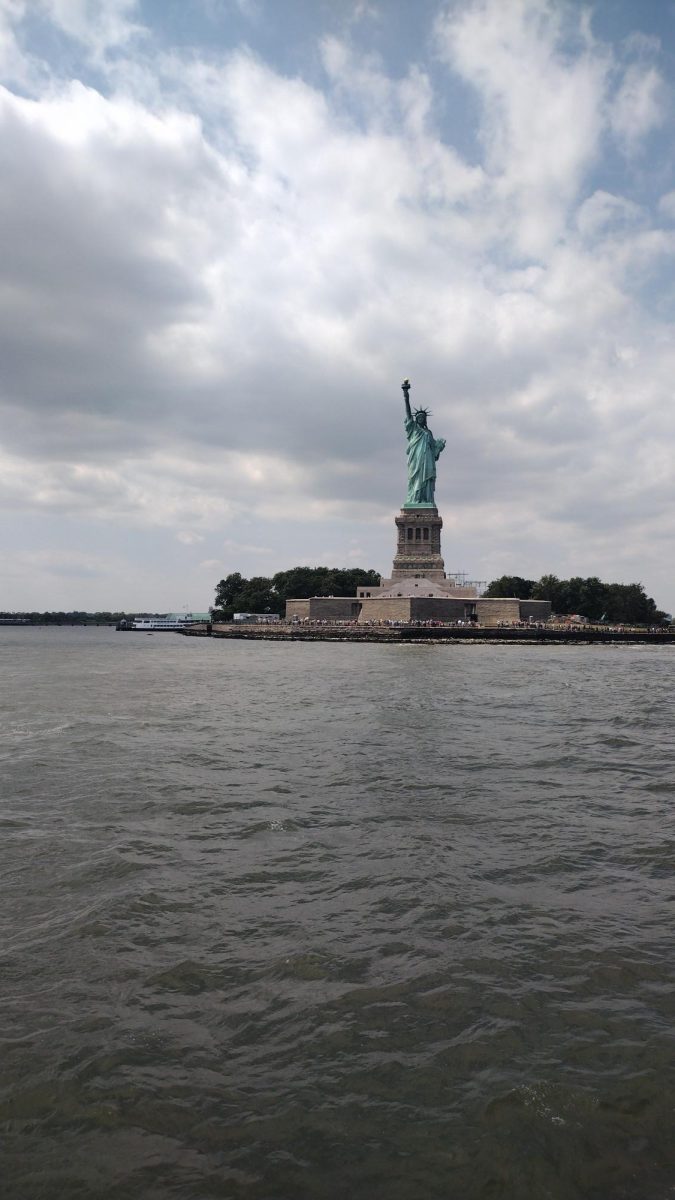There are over 400 national parks in the US and territories yet many don’t know much about them. A national park is an area, park, route, parkway, reserve, or recreational space that is federally protected with some historical or environmental significance.
Many individuals who visit US national parks don’t realize there is a way to document their travels and engage further. Enthusiasts and casual travelers can purchase a copy of the National Park Explorer Edition Passport book online at Shop.americasnationalparks.org or at any park store. The purchase includes a pen, historical information on each park, a map, checklists for national parks, stamp slots for stamps, and three pocket sleeves.
There are two different stamps a visitor can obtain: a cancellation stamp and a sticker stamp. Cancellation stamps include the name of the national park, date of the visit, and the state or territory the park is located. Sticker stamps include a photo of the park, the region the park is located, and a description of the park. Stamps can be found at the information desks at the parks or at any merchandise store.
Although documenting experiences at US National Parks is delightful for travel enthusiasts, it is important to understand the information and regulations of national parks. A important detail to keep in mind is to be mindful of where and how you choose to explore or stay overnight at camps because some parks are not designed for camping or may require special entry/tickets for camping and overnight stays (Example: The Everglades is designed for overnight stays and fishing, but the Robert E. Lee House is designed specifically as a walk-in museum).
Visitors should also be mindful of pet policies within the parks. Whether a pet is allowed in a park can vary depending on seasons, wildlife, conditions, and the individual park’s regulations. Some designated park areas will allow all leashed pets while other areas may allow only service animals or animals that aid with disabilities (Example: In the Everglades, pets are typically allowed in many areas; however, alligator trails bar pets due to safety concerns).
Along with restrictions on pets, certain animals at national parks have restrictions and penalties for hunting. Hunting and fishing wildlife that is protected can lead to criminal fines up to $50,000, jail time, and forfeiting tools used in the hunting for violating the Endangered Species Act to protect wildlife. This is done to prevent certain endangered species from becoming extinct. (Example: In Biscayne National Park Florida, it is considered illegal to touch, harass, kill, feed, or interact with manatees due to their endangered status).
Other than the safety of animals, human safety is also important. The US National Parks are federal property run by the Department of the Interior which subjects individuals in certain parks to bag inspections and security screenings/ checks. Prohibited items include weapons, illegal substances, overly large unapproved bags, drones, metal detectors, and in certain areas food or drinks. (Example: Ellis Island does not allow drinks in the lines to get audio tour devices.) Rangers and officers can be found throughout the parks or at information desks if any suspicious activities occur.
“This policy is fair and warranted. All sorts of people go into national parks and one does not know what they can be carrying or hiding with them,” said senior Esther Diaz.
After examining the policies and park rules you may wonder, “What national park or monument do I visit?” There are 400+ parks which include the following:
Yellowstone National Park, WY. Yellowstone was the first park admitted as a US National Park. It is loved and well known by tourists worldwide for its beautiful landscape and diverse geothermal features. It contains the world’s largest concentration of geysers and supports many animals such as wolves, buffalo, and other animals It is one of the few national parks where buffalo roam naturally in the wild since prehistoric times as they are protected under a 1894 act enacted to lower buffalo hunting rates. Yellowstone is also known for its unique setting since it is located atop an active super volcano. Yellowstone also contains mining history from a time period when Yellowstone was not a park and people went there in search of gold or other metals.
“That is a great law because it helps protect our wonders,” said Coral Gables Senior High senior, Alexander Mederos.
Grand Canyon National Park, AZ. Grand Canyon takes its history as a sacred ancestral site for indigenous individuals, having been established as a national park by President Theodore Roosevelt to be preserved and avoid the risk of its destruction from individuals mining or seeking metals or gold. Grand Canyon is also known for its wonderful rock formations with the oldest formations at the base of the formation and the newest formation resting at the top. It attracts 4.7 to 5 million visitors a year. The Grand Canyon offers guided tours and camping areas.
“It was like huge. It made me feel like a speck of dust and it was beautiful,” said senior Gabriella Garmendia.
Dry Tortugas Key West, FL. Dry Tortugas is a national park surrounded by water on all sides and has its history as a Civil War fort. The only way the fort is accessed is via seaplane or ferry. It is known for its crystal clear waters with diverse marine life. Tourists can see the historic pathways and the museum located inside the fort. The park is perfect for scuba diving, snorkeling, bird watching, and kayaking.
The Everglades Homestead, FL. The Everglades is a National Park with massive ecological significance. The Everglades serves as a home for over 2,000 different species of animals. It became a protected park in 1947 to preserve its ecosystem and the animals that call this place home. Tourists can go on boat tours that explain the ecosystem by purchasing tickets at an information booth, kayak in designated areas, walk on the alligator trails to see the wildlife (keep in mind that pets are not allowed on this trail), and visit the Nike Missile from the Cuban Missile Crisis.
“The Everglades is such a unique area to Florida. You will find no other place like it in the world,” said senior Esther Diaz.
Ellis Island National Museum Of Immigration NY/NJ. Ellis Island is a museum that was formerly an immigration processing facility. Arriving immigrants received checks on their physical and mental health, and be scrutinized for any violations of immigration law. Immigrants denied entry having failed the check, remained in cramped rooms until they were either approved or sent back. The deportation rate was low at Ellis Island and in later years it was used as a detention center when immigration policies changed before eventually closing its doors. After being abandoned, massive restorations were carried out during the mid-1980s. It now stands today as a museum with self-guided audio tours available in multiple languages, accessible elevators, and a gift store. It can be traveled to via ferry.
Statue Of Liberty National Monument NY/NJ. the Statue of Liberty is one of the most iconic statues in the world. It is considered the 4th most popular area to be entered as a national monument. The Statue of Liberty was received as a gift from France and given to New York. The copper statue has oxidized over the span of many years. Visitors can visit the pedestal and the inside of the statue. Inside the pedestal is a museum on the history of the Statue of Liberty and the stairs to the top of the pedestal. At the top of the pedestal awaits a scenic view of the Hudson and the NYC skyline. From the pedestal are the stairs to the crown of the statue where a window shows the view below. Be mindful that it gets crowded and it is best to visit during winter because many visitors get heatstroke when climbing the stairs during the summer.
Independence National Historic Park Philadelphia, PA. Independence National Historical Park contains the Liberty Bell and Independence Hall. The Liberty Bell is historically known for representing freedom in America. On the bell, there is a biblical inscription that reads “Proclaim Liberty Throughout All the Land Unto All the Inhabitants Thereof” The quote became a rallying cry for abolitionists. In turn with the Liberty Bell, in Independence National Historic Park is Independence Hall. Independence Hall was the building where the Constitution and the Declaration of Independence were signed. Independence Hall requires a ticket to enter.
San Juan Fort National Site, PR. The San Juan Fort, also known as Castillo San Felipe del Morro, is rooted in centuries-old Spanish roots when Spain controlled Puerto Rico and used it to protect against pirates and other world powers. It overlooks the Atlantic Ocean and is available for tourists to visit. From the cannons, to the ocean, to the lighthouse atop, the fort makes its presence known. When exploring the fort, exercise caution because many of the stairs and inclines are steep.
Redwood National Park, California. The Redwoods are one of the most unique trees in all of the national parks. The Redwood Trees are considered the tallest trees in the world with some surpassing 380ft in height. These trees can live for more than 2,000 years and have an ancient lineage dating back before the existence of the dinosaurs. The trees are also known for being strong, resilient, and their fireproof bark. The trees are protected due to their endangered nature unless an individual has a specific permit. Many individuals have been protesting against cutting Redwood Trees altogether.
Many adventures await for you beyond the shinning sun among the national parks Remember to take this information along, have fun, and stay safe!










